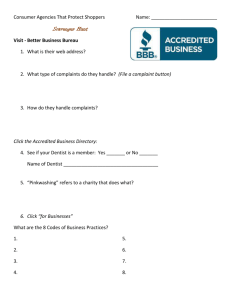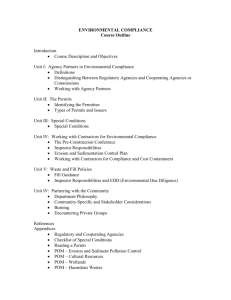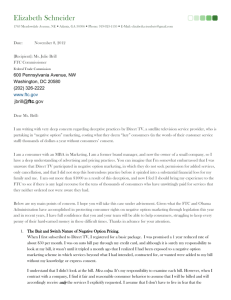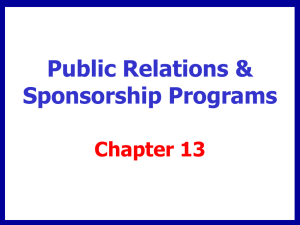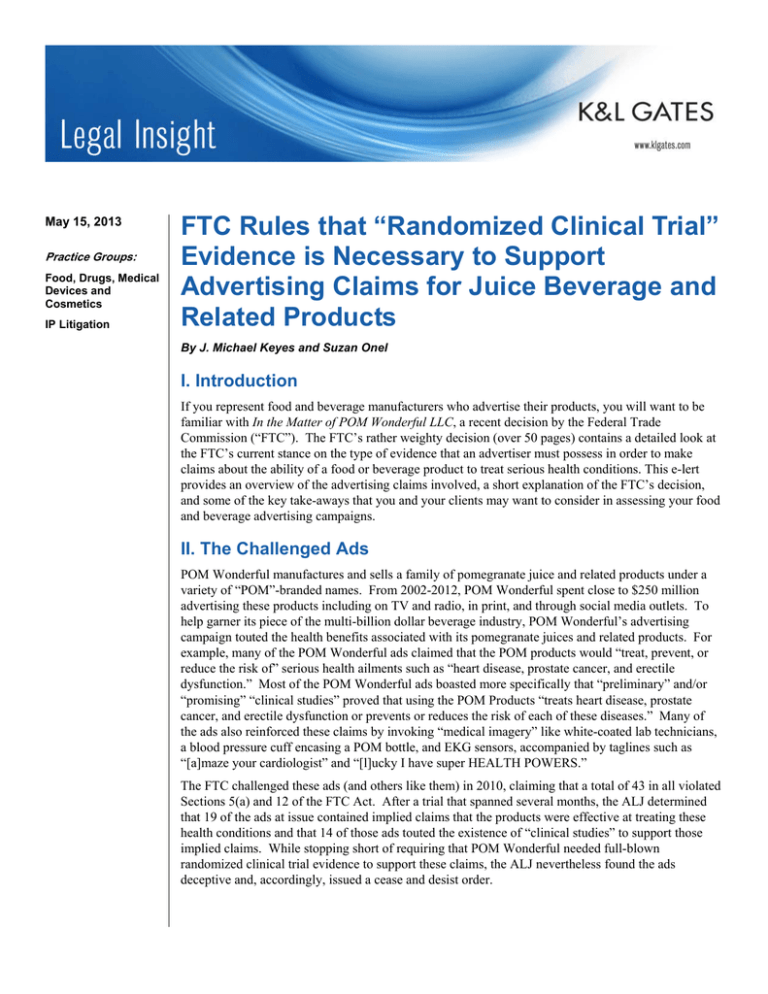
May 15, 2013
Practice Groups:
Food, Drugs, Medical
Devices and
Cosmetics
IP Litigation
FTC Rules that “Randomized Clinical Trial”
Evidence is Necessary to Support
Advertising Claims for Juice Beverage and
Related Products
By J. Michael Keyes and Suzan Onel
I. Introduction
If you represent food and beverage manufacturers who advertise their products, you will want to be
familiar with In the Matter of POM Wonderful LLC, a recent decision by the Federal Trade
Commission (“FTC”). The FTC’s rather weighty decision (over 50 pages) contains a detailed look at
the FTC’s current stance on the type of evidence that an advertiser must possess in order to make
claims about the ability of a food or beverage product to treat serious health conditions. This e-lert
provides an overview of the advertising claims involved, a short explanation of the FTC’s decision,
and some of the key take-aways that you and your clients may want to consider in assessing your food
and beverage advertising campaigns.
II. The Challenged Ads
POM Wonderful manufactures and sells a family of pomegranate juice and related products under a
variety of “POM”-branded names. From 2002-2012, POM Wonderful spent close to $250 million
advertising these products including on TV and radio, in print, and through social media outlets. To
help garner its piece of the multi-billion dollar beverage industry, POM Wonderful’s advertising
campaign touted the health benefits associated with its pomegranate juices and related products. For
example, many of the POM Wonderful ads claimed that the POM products would “treat, prevent, or
reduce the risk of” serious health ailments such as “heart disease, prostate cancer, and erectile
dysfunction.” Most of the POM Wonderful ads boasted more specifically that “preliminary” and/or
“promising” “clinical studies” proved that using the POM Products “treats heart disease, prostate
cancer, and erectile dysfunction or prevents or reduces the risk of each of these diseases.” Many of
the ads also reinforced these claims by invoking “medical imagery” like white-coated lab technicians,
a blood pressure cuff encasing a POM bottle, and EKG sensors, accompanied by taglines such as
“[a]maze your cardiologist” and “[l]ucky I have super HEALTH POWERS.”
The FTC challenged these ads (and others like them) in 2010, claiming that a total of 43 in all violated
Sections 5(a) and 12 of the FTC Act. After a trial that spanned several months, the ALJ determined
that 19 of the ads at issue contained implied claims that the products were effective at treating these
health conditions and that 14 of those ads touted the existence of “clinical studies” to support those
implied claims. While stopping short of requiring that POM Wonderful needed full-blown
randomized clinical trial evidence to support these claims, the ALJ nevertheless found the ads
deceptive and, accordingly, issued a cease and desist order.
FTC Rules that “Randomized Clinical Trial” Evidence is
Necessary to Support Advertising Claims for Juice
Beverage and Related Products
III. The FTC Decision and the Key Take-Aways
In its detailed order reviewing the ALJ’s decision, the FTC reviewed each of the ads at issue, the
messages conveyed therein, and the underlying substantiation for the advertising claims as introduced
at trial. The FTC went further than the ALJ and found that 36 of the 43 ads were deceptive. Although
an in-depth review of the FTC order with respect to the individual ads is beyond the scope of this elert, there are a couple of key take aways that should be considered.
First, most of the ads produced by POM Wonderful contained “establishment” claims in that they
specifically referenced “clinical trials” that allegedly showed that the POM Products were effective at
treating, preventing, or reducing the risk of heart disease, prostate cancer, and ED. According to the
FTC, when an advertiser claims that its food or beverage products treat, prevent, or reduce “serious
diseases” such as the ones at issue, the advertiser must have “Randomized Clinical Trial” (“RCT”)
evidence to back up those advertising claims. A properly structured RCT will select participants
randomly, will be double-blind, and will have both a test group and a control group. While POM
Wonderful produced expert testimony regarding certain studies and other medical research regarding
the general “health benefits” associated with pomegranates and pomegranate juice, the FTC found this
evidence did not meet the RTC gold standard in a number of respects. The FTC also rejected the
notion that requiring RCTs for food product health claims rises to the same level as the FDA’s
standards for proof of drug claims. The Commission made clear it was not holding POM to a
pharmaceutical standard, because the FDA regulations for drugs require multiple phases of clinical
trials producing different and greater substantiation than what the FTC required of POM.
Interestingly, the FTC found that the POM products were food and dietary supplements, but also that
they made disease prevention claims, a notable feature of what the FDA considers a drug claim.
Thus, the key holding in the decision makes it clear that when an advertiser claims that a food or
beverage product helps treat, reduce or prevent serious diseases, the FTC is going to expect robust
substantiation in the form of RCTs.
Second, consistent with prior FTC precedent, the decision makes it clear that when reviewing an ad
for compliance with the FTC Act, it is necessary to consider the entire “gestalt” of the ad itself instead
of considering individual elements. This principle was particularly important here because although
some of the ads did not expressly rely on “scientific” evidence per se, the imagery and creative
execution of those ads, particularly when combined with the text, would leave the consumer with the
impression that using the POM Products at issue would be effective at treating, preventing, or
reducing the risk of disease. For example, a POM bottle in the shape of an intravenous bag, the use of
the Caduceus (a well-recognized symbol of the medical profession), and white-coated scientists all
reinforced the message that these products at issue were effective in treating and preventing the
serious health conditions that were mentioned in the ads. The FTC’s treatment of the imagery is an
important reminder that the visual effects of an ad simply cannot be divorced from the text. The
unitary whole should always be considered.
Finally, the FTC decision also discusses the use of “qualifiers.” In several of the ads, the scientific
evidence relied upon was characterized as “preliminary,” “promising,” “encouraging,” or “hopeful.”
POM Wonderful argued that because it qualified the nature of the clinical studies in this way, these
particular ads were not making “establishment claims.” The FTC rejected the argument finding that
POM Wonderful’s “use of one or two adjectives does not alter the net impression that clinical studies
2
FTC Rules that “Randomized Clinical Trial” Evidence is
Necessary to Support Advertising Claims for Juice
Beverage and Related Products
prove their claims. This is especially true when the chosen adjectives – promising, encouraging, or
hopeful – provide a positive spin on the studies rather than a substantive disclaimer.”
IV. Conclusion
In the Matter of POM Wonderful LLC is an important decision to keep in mind when considering the
type of health and wellness claims that can be made when it comes to food and beverage products.
The claim-substantiation standard appears to have been raised to a level that is closer to what is
required of drug claims, but that is applied here across product lines to food and beverage products. If
the advertising claims impliedly or expressly assert that the product helps treat, prevent or reduce the
risk of a serious health condition, then it will be necessary to back that up with well-designed and
well-executed RCTs.
Authors:
J. Michael Keyes
mike.keyes@klgates.com
+1.509.241.1527
Suzan Onel
susan.onel@klgates.com
+1.202.778.9134
Anchorage Austin Beijing Berlin Boston Brisbane Brussels Charleston Charlotte Chicago Dallas Doha Dubai Fort Worth Frankfurt
Harrisburg Hong Kong Houston London Los Angeles Melbourne Miami Milan Moscow Newark New York Orange County Palo Alto Paris
Perth Pittsburgh Portland Raleigh Research Triangle Park San Diego San Francisco São Paulo Seattle Seoul Shanghai Singapore Spokane
Sydney Taipei Tokyo Warsaw Washington, D.C. Wilmington
K&L Gates practices out of 48 fully integrated offices located in the United States, Asia, Australia, Europe, the
Middle East and South America and represents leading global corporations, growth and middle-market companies,
capital markets participants and entrepreneurs in every major industry group as well as public sector entities,
educational institutions, philanthropic organizations and individuals. For more information about K&L Gates or its
locations, practices and registrations, visit www.klgates.com.
This publication is for informational purposes and does not contain or convey legal advice. The information herein should not be used or relied upon in
regard to any particular facts or circumstances without first consulting a lawyer.
©2013 K&L Gates LLP. All Rights Reserved.
3


